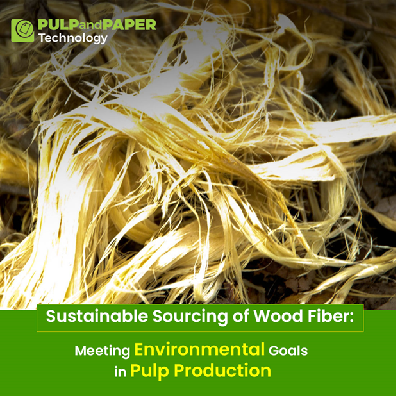Sustainable Sourcing of Wood Fiber: Meeting Environmental Goals in Pulp Production

Introduction
The global pulp and paper industry holds a pivotal role in our daily lives, providing essential products like paper, packaging materials, and textiles. Nevertheless, it cannot escape scrutiny for its substantial environmental impact. The unsustainable acquisition of wood fiber for pulp production has resulted in issues such as deforestation, habitat degradation, and the emission of carbon. To tackle these challenges head-on, the industry is progressively transitioning towards sustainable sourcing practices. These practices are designed to not only meet environmental objectives but also ensure the continued production of vital products. In this article, we will delve into the significance of sustainable wood fiber sourcing and its role in assisting the pulp production sector in achieving its environmental goals.
The Environmental Challenge
The pulp and paper industry has long been associated with environmental concerns. Historically, the industry relied heavily on clear-cutting forests, leading to deforestation and loss of biodiversity. These practices also released significant amounts of carbon dioxide into the atmosphere, contributing to climate change. In response to these issues, there has been a growing push for sustainability in the industry.
Sustainable Wood Fiber Sourcing
Sustainable wood fiber sourcing is the cornerstone of environmentally responsible pulp production. This approach emphasizes the responsible management of forests, including reforestation and afforestation efforts. Sustainable sourcing practices include:
1. Forest Certification: Forest certification initiatives, such as the Forest Stewardship Council (FSC) and the Programme for the Endorsement of Forest Certification (PEFC), establish criteria for the sustainable management of forests. These certifications provide assurance that forest practices are conducted in ways that minimize environmental impact and protect biodiversity.
2. Responsible Logging Practices: Sustainable sourcing requires responsible logging practices that minimize damage to ecosystems, protect wildlife habitats, and prevent soil erosion. Modern logging techniques, such as selective cutting and reduced-impact logging, are designed to reduce environmental harm.
3. Reforestation and Afforestation: Sustainable forestry practices also include replanting trees to ensure a continuous supply of wood fiber. Reforestation and afforestation efforts help restore ecosystems and sequester carbon, mitigating the industry's carbon footprint.
4. Chain of Custody Certification: Chain of custody certification ensures that wood fiber used in pulp production comes from sustainable sources and is tracked throughout the supply chain. This transparency helps consumers make informed choices about the products they purchase.
Benefits of Sustainable Sourcing
Sustainable sourcing of wood fiber offers numerous benefits for the environment, society, and the pulp production industry itself.
1. Conservation of Biodiversity: Sustainable forestry practices protect natural habitats and biodiversity. By avoiding clear-cutting and promoting responsible logging, these practices help preserve the diverse ecosystems that depend on forests.
2. Carbon Sequestration: Forests play a vital role in carbon sequestration. Sustainable forestry practices, such as reforestation and afforestation, bolster the ability of forests to capture and retain carbon dioxide, contributing to the mitigation of climate change.
3. Long-term Resource Availability: Sustainable sourcing ensures a long-term supply of wood fiber. By replanting and managing forests responsibly, the industry can meet its production needs without depleting natural resources.
4. Reduced Environmental Impact: Sustainable practices reduce the environmental impact of pulp production, including reduced carbon emissions, minimized water usage, and decreased chemical pollution.
5. Positive Brand Image: Companies that commit to sustainable sourcing can enhance their brand image and appeal to environmentally conscious consumers. Sustainable practices demonstrate a commitment to corporate social responsibility.
Challenges and Barriers
While the transition to sustainable wood fiber sourcing is crucial, it is not without its challenges and barriers.
1. Economic Pressures: Sustainable sourcing practices can be more expensive in the short term, leading some companies to resist the change due to concerns about profitability.
2. Certification Costs: Obtaining and maintaining forest certification can be costly for forest owners and pulp producers, which can deter participation in sustainability programs.
3. Regulatory Differences: Variations in forest management regulations and certification requirements across regions and countries can make it challenging to implement consistent sustainable sourcing practices.
4. Consumer Demand: Despite growing interest in sustainability, not all consumers are willing to pay a premium for sustainably sourced products, which can create market challenges.
Sustainable Innovations
Innovations in sustainable sourcing have been instrumental in driving the pulp production industry towards more eco-friendly practices. One such innovation is the development of alternative fiber sources. While traditional wood fiber remains essential, the industry is exploring new sources, including agricultural residues, non-wood plants, and recycled paper. These alternatives reduce the pressure on forests and offer a more diversified and sustainable supply chain.
Additionally, advancements in technology have improved the efficiency of pulp production processes. Modern pulp mills are designed to minimize waste, energy consumption, and water usage. Closed-loop systems, for instance, allow mills to recycle and reuse water, reducing the overall environmental footprint. Moreover, cutting-edge biorefinery concepts enable the extraction of valuable chemicals and materials from wood, making the industry more resource-efficient.
Collaboration and Supply Chain Transparency
Effective collaboration throughout the supply chain is imperative for the achievement of sustainable wood fiber sourcing goals. This necessitates cooperation among forest proprietors, pulp manufacturers, industrial producers, and consumers alike. Sustainable sourcing demands a harmonized endeavor to guarantee the implementation of responsible practices at every phase.
Transparency is another key element. Companies that prioritize sustainability should provide clear information about their sourcing practices, certifications, and environmental performance. This transparency not only builds trust with consumers but also encourages other players in the industry to follow suit.
Government Support and Regulations
Government regulations and policies also play a significant role in promoting sustainable wood fiber sourcing. Many countries have implemented laws that require forest management to meet certain environmental standards. Additionally, government incentives and subsidies can encourage companies to adopt sustainable practices by offsetting some of the initial costs associated with certification and responsible forest management.
International agreements and conventions, such as the United Nations Sustainable Development Goals (SDGs) and the Paris Agreement, further emphasize the importance of sustainability in the pulp and paper industry. Companies that align their practices with these global goals are more likely to gain international recognition and access to new markets.
Conclusion
The shift towards sustainable sourcing of wood fiber in pulp production represents a critical step in addressing the environmental challenges associated with the industry. Through responsible forest management, certification programs, innovation, and collaboration, the industry can meet its environmental goals while continuing to provide essential products to consumers worldwide. As public awareness of environmental issues grows, sustainable sourcing will not only benefit the planet but also strengthen the industry's competitiveness and resilience in the global marketplace. Embracing sustainability is not just an option; it's a necessity for the future of the pulp production industry.









